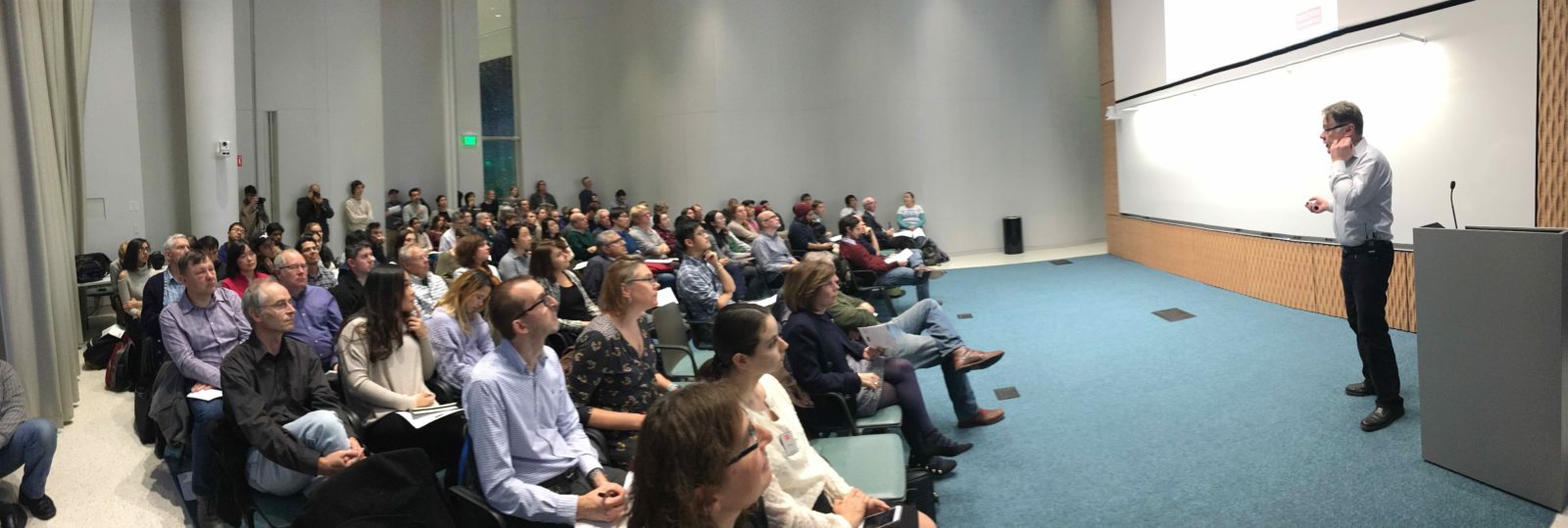BU Neurophotonics Center Launches with ‘Research on Tap’ Talks!
The BU Neurophotonics Center opened its doors to the public last month with a series of events highlighting both the work of its faculty and the latest advances in the field generally.
On Wednesday, November 29, Center faculty joined the BU “Research on Tap” series for a rapid-fire series of talks: “Illuminating How the Brain Works—With the Help of BU Neurophotonics.” The next day was witness to the 21st annual Photonics Center Symposium, with researchers from across the U.S. and abroad shining a light on neurophotonics and the many ways it can boost a host of applications.
The Wednesday event was an especially apt kick-off as it introduced much of the work already in progress in the Neurophotonics Center, and in doing so demonstrated both the depth and the breadth of the research taking place under its roof. In all, 12 of the 31 faculty affiliated with the Center spoke about their work, representing an array of departments within BU: Biomedical Engineering, Psychological & Brain Sciences, Medicine, and more.
Not surprisingly, given the diversity of the speakers, the talks described both technology development and applications studies. On the technology development front, for example, Jerome Mertz, Professor of Biomedical Engineering, spoke about his group’s efforts to tackle the problem of dynamic range, particularly with the imaging modality two-photon microscopy. Their solution to the problem: an “adaptable” microscope that changes laser power as it is scanning, so it is delivering power only where and when it is needed. This yielded an extraordinary 16,000-fold increase in dynamic range, he said, surely a welcome improvement for the neurobiologists who use two-photon microscopy.
Michelle Sander, Assistant Professor of Electrical & Computer Engineering, addressed another longstanding concern in the instrumentation realm. Particular ultrafast lasers offer exceptionally high spatial resolution but, unfortunately, often don’t overlap with the desired “biological windows”—the wavelength ranges where the laser light optimally penetrates biological tissue. To right this imbalance, she and her group worked to develop a fiber laser system based on the thulium materials that overlaps well with biological windows, and have begun to explore its potential for infrared nerve stimulation, an important emerging application.
The goal of technology development, of course, is to help researchers approach problems in innovative ways and from novel perspectives—to see the problems, both literally and figuratively, as they never have before. Many of the talks on Wednesday pulled back the curtains to show how this is happening in the Center. For instance, Meryem Yucel, Research Assistant Professor in Biomedical Engineering, described an emerging optical monitoring technology—functional near-infrared spectroscopy (fNIRS)—and the myriad ways it can be put to use. Not least among these: she and colleagues are exploring its potential for research and clinical applications in Alzheimer’s, autism and stroke.
Some of the applications discussed in the talks sounded almost futuristic in their scope. Steve Ramirez, Assistant Professor of Psychological & Brain Sciences, described his group’s successful efforts to suppress painful memories and prevent a “fear response” in mice by artificially activating positive memories with light. They achieved this, he said, by identifying the neurons underlying those memories and genetically engineering them to respond to light. This, naturally, could have profound implications especially for the treatment of psychiatric disorders.
Artificial intelligence also made an appearance. Jeffrey Gavornik, Assistant Professor of Biology, spoke about using calcium imaging to investigate the neural basis of learned temporal relationships. This is particularly relevant for the ongoing development of AI, he said. Today, AI is not actually a true representation of how the brain works; it doesn’t fully replicate the mechanisms by which the brain processes new information on a temporal level. Better understanding how this happens will help in bringing about the next stage of the AI revolution.
Videos of all of the talks can be found here.
Neurophotonics trainees pitch research to Canadian counterparts
The “Research on Tap” event wasn’t the only occasion that day to hear about what is happening in the Neurophotonics Center. A few hours before the event, trainees in the Neurophotonics National Science Foundation Research Traineeship Program (NRT) at BU had a virtual research exchange with graduate students at Laval University’s Neurophotonics Center in Quebec City, Canada. Students from the two campuses exchanged 15- to 90-second research pitches, using techniques adapted from abbreviated Alan Alda Science Communications training they received from the Program Coordinator of the NRT, Helen Fawcett.
The goal of this research exchange was for the students to communicate their research without resorting to scientific jargon, paving the way for future discussions and potential collaborations between the two centers. More exchanges between faculty and students, both virtually and in person, will take place over the coming year. Just one example: two trainees from the BU program will attend Laval’s Frontiers in Neurophotonics Summer School, where several neurophotonics faculty from BU have and will continue to give lectures.
